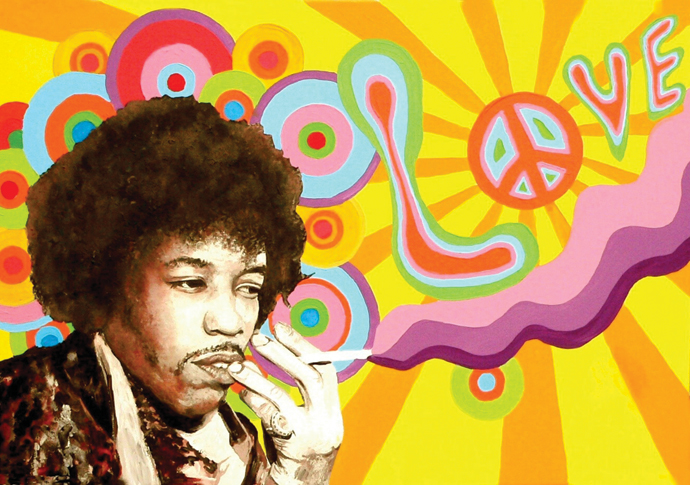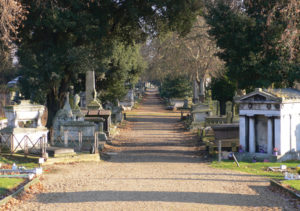Purple patch
On this week's virtual ramble, Diary drops in on Droop Street, tracks down some railway heroes, and rocks out at the famous BBC Maida Vale studios
Thursday, 28th May 2020 — By The Xtra Diary

Jimi Hendrix. PHOTOS: JUSTINC/MAX HALBERSTADT
WE’VE had a week off to rest our weary limbs – and off we go again with our virtual tour of the borough.
We had strayed briefly into Kensington and Chelsea as we couldn’t resist following the beat of the Carnival. But Diary had better get back on track as there’s still plenty to do in our home of Westminster, a borough where every street tells a story…
So from a perch on a wall in Cambridge Gardens, where Norman Jay’s Good Times Sound System first played Carnival, we head back up Ladbroke Grove until we reach the famous Kensal Green Cemetery.
While Westminster is famous for the three cemeteries sold for a grand total of 15p by Dame Shirley Porter – just one of a number of scandals that engulfed the Tory council in the 1980s – Kensal Green was thankfully not under the council’s jurisdiction.
It is the resting place of plenty of famous people, ranging from black activist Marcus Garvey, who was buried there in 1940 before his body was repatriated to Jamaica, to Victorian tightrope walker Emile Blondin, who traversed Niagara Falls on a flimsy rope.
Let us pause by the graves of two lesser-known men, who deserve utmost respect. Train driver Walter Peart and his fireman Henry Dean died in 1898.
Their graves were built by the Amalgamated Society of Railway Servants – they lost their lives as they saved passengers on the Paddington to Windsor express. Their train’s boiler exploded and the pair were seriously injured, but they did all they could to get the runaway train to a standstill before they sought help for themselves, saving lives of hundreds. Their graves include a plaque marking their heroism, and a relief sculpture of a train.

Sigmund Freud
Next up, we’ll head along nearby Droop Street, partly because it has an excellent name, and partly to mark the person who built it.
Victorian developer William Austin started his working life being paid 1p a day as a scarecrow on a farm. He worked his way up to running a firm that built drains – and then spent his fortune on building homes for workers.
He created the 2,000 Gothic-style cottages around Queen’s Park – and Droop Street was one of the roads he built. It took the name from a Mr Droop, who was a director of Mr Austin’s Artizans, Labourers & General Dwellings Company.
From here, let’s head back along the Harrow Road, and pause outside the All Stars Boxing Gym.
Established by Ghana-born Isola Akay MBE, it has become a stable for champs – but more importantly, a magnet for young people who want to work out and learn the discipline. In 1974, Mr Akay’s son, Tee Jay, wanted to box but he and his friends were banned from other gyms in the area because they were considered to be disruptive. Mr Akay took it on himself to give them training sessions on Paddington Rec – eventually earning rightful respect and finding a permanent home. Aware of the poor relationship between young people and the police, he had the brainwave of inviting coppers in to train.
Mr Akay’s dedication and brilliance has become a beacon in the neighbourhood – and produced a few winners at the Police Boxing Championships, too.

Kensal Green Cemetery
Leaving behind the atmosphere of the ring, we will schlep up to the BBC Maida Vale studios. Dating from 1909, it was originally an ice-skating rink before “Auntie” moved in. In 1934, it became home to the BBC Symphony Orchestra (in which your correspondent’s uncle played lead flute!) and then became the centre for news broadcasting throughout the Second World War.
It has a glorious backstory, in terms of artists who have recorded there.
The John Peel Sessions ran from one of its studios between 1967 and 2004. Led Zeppelin and The Beatles, Jimi Hendrix and David Bowie all sang and strummed into the Maida Vale microphones – though The Clash only completed half a session, after saying the recording equipment wasn’t up to scratch, a complaint that Peel said was “unbelievably pretentious of them”.
Nearby, we’ll admire the cream facades of Warrington Crescent, where computer genius and posthumous war hero Alan Turing was born in 1924. It started life as a boarding school and then became The Warrington Lodge Medical and Surgery Home for Ladies. Converted into a hotel in the mid-1930s, Sigmund Freud enjoyed an extended stay in its upper floors while he did up his Hampstead home.
At the end of the road is another hotel, named The Warrington. Its interior is amazing – stained-glass windows and mosaic floors, mahogany throughout and marble fireplaces.
In the bar is a series of Art Nouveau-style murals, featuring scantily clad ladies – apparently a nod to the fact it was once a brothel that enjoyed the patronage of many a peer.
It is said that Randolph Avenue, on whose corner it sits, gave the English language the term “randy” to signify someone keen to enjoy time between the sheets with another.
And on that note, we’ll retire to admire the illustrations with a cold beer in our hands. Until next week, stay safe.